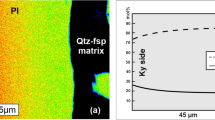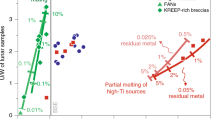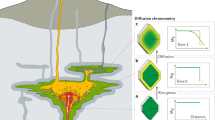Abstract
Replying to F. M. Richter Nature 472, 10.1038/nature09954 (2011)
In our Letter1, we showed that the phenomenon of isotope fractionation in silicate melts by thermal diffusion, first reported in 1998 (ref. 2), can be characterised by a parameter ΔST that is independent of temperature and composition. (Here ΔST is the difference in the Soret coefficient, ST, between isotopes of a diffusing element.) Richter3 questioned this finding by plotting Mg isotope ratio versus temperature data (figure 1 in ref. 3) for a subset of experiments from figure 3f of ref. 1.
This is a preview of subscription content, access via your institution
Access options
Subscribe to this journal
Receive 51 print issues and online access
$199.00 per year
only $3.90 per issue
Buy this article
- Purchase on Springer Link
- Instant access to full article PDF
Prices may be subject to local taxes which are calculated during checkout

Similar content being viewed by others
References
Huang, F. et al. Isotope fractionation in silicate melts by thermal diffusion. Nature 464, 396–400 (2010)
Kyser, T. K., Lesher, C. E. & Walker, D. The effects of liquid immiscibility and thermal diffusion on oxygen isotopes in silicate liquids. Contrib. Mineral. Petrol. 133, 373–381 (1998)
Richter, F. M. Isotope fractionation in silicate melts by thermal diffusion. Nature 472, 10.1038/nature09954 (this issue).
Huang, F. et al. Chemical and isotopic fractionation of wet andesite in a temperature gradient: experiments and models suggesting a new mechanism of magma differentiation. Geochim. Cosmochim. Acta 73, 729–749 (2009)
Astumian, R. D. Coupled transport at the nanoscale: the unreasonable effectiveness of equilibrium theory. Proc. Natl Acad. Sci. USA 104, 3–4 (2007)
Debuschewitz, C. & Kohler, W. Molecular origin of thermal diffusion in benzene + cyclohexane mixtures. Phys. Rev. Lett. 87, 055901 (2001)
Putnam, S. A., Cahill, D. G. & Wong, G. C. L. Temperature dependence of thermodiffusion in aqueous suspensions of charged nanoparticles. Langmuir 23, 9221–9228 (2007)
Reith, D. & Muller-Plathe, F. On the nature of thermal diffusion in binary Lennard-Jones liquids. J. Chem. Phys. 112, 2436–2453 (2000)
Richter, F. M. et al. Magnesium isotope fractionation in silicate melts by chemical and thermal diffusion. Geochim. Cosmochim. Acta 72, 206–220 (2008)
Richter, F. M. et al. Isotopic fractionation of the major elements of molten basalt by chemical and thermal diffusion. Geochim. Cosmochim. Acta 73, 4250–4263 (2009)
Lesher, C. E. & Walker, D. Solution properties of silicate liquids from thermal diffusion experiments. Geochim. Cosmochim. Acta 50, 1397–1411 (1986)
Lesher, C. E. & Walker, D. in Diffusion, Atomic Ordering, and Mass Transport (ed. Ganguly, J. ) 396–451 (Adv. Phys. Geochem. 8, Springer, 1991)
Author information
Authors and Affiliations
Corresponding author
Ethics declarations
Competing interests
Competing financial interests: declared none.
PowerPoint slides
Rights and permissions
About this article
Cite this article
Huang, F., Chakraborty, P., Lundstrom, C. et al. Huang et al. reply. Nature 472, E2–E3 (2011). https://doi.org/10.1038/nature09955
Published:
Issue Date:
DOI: https://doi.org/10.1038/nature09955
This article is cited by
-
Adaptive evolution of loci covarying with the human African Pygmy phenotype
Human Genetics (2012)
Comments
By submitting a comment you agree to abide by our Terms and Community Guidelines. If you find something abusive or that does not comply with our terms or guidelines please flag it as inappropriate.



